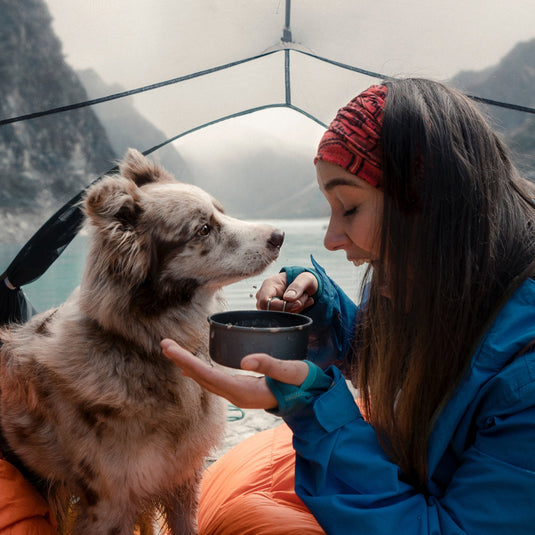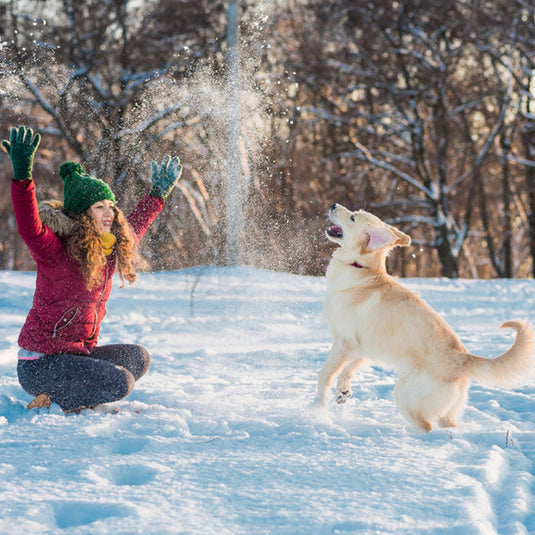Winter camping with your dog can be an unforgettable experience, offering a quiet, serene environment and the joy of exploring nature together in the crisp, cool air. Whether you're heading into the mountains, trekking through snowy forests, or just camping at a local winter park, there are many benefits to sharing this adventure with your furry companion.
However, winter camping presents unique challenges that require special preparation and attention to ensure both you and your dog stay safe, warm, and comfortable. From selecting the right gear to keeping your dog healthy in the cold, here are some essential tips for going camping with your dog in winter.
1. Check Your Dog’s Health and Fitness Level
Before you embark on a winter camping trip, it’s important to make sure your dog is physically prepared for cold weather and outdoor activities. Not all dogs are suited for winter camping, especially those with short coats, older dogs, or dogs with health issues.
- Check with Your Vet: Make sure your dog is up to date on vaccinations and in good overall health, especially if you plan on hiking or engaging in physically demanding activities.
- Breed Considerations: Some breeds are better suited for cold weather than others. Breeds like Huskies, Saint Bernards, and Bernese Mountain Dogs have thicker coats and are naturally better equipped to handle colder temperatures. Short-haired or small dogs may require more protection from the cold, including jackets or sweaters.
2. Pack the Right Gear for Your Dog
Winter camping requires extra gear to keep your dog comfortable and safe. Here are some essentials you’ll want to pack for your dog:
- Dog Jacket or Sweater: Even cold-weather breeds may need an extra layer, especially if temperatures drop significantly. Look for water-resistant, insulated jackets or sweaters to help keep your dog warm during hikes or while relaxing at the campsite.
- Boots for Dogs: Dogs' paws can be sensitive to cold, ice, and salt. Invest in a pair of dog boots to protect their paws from freezing surfaces, sharp ice, or salt used on paths. If your dog won’t tolerate boots, regularly check their paws for injury, ice build-up, or cracks.
- Dog Sleeping Bag or Blanket: Bring a warm sleeping pad or bag designed for dogs to ensure your dog stays warm through the night. Many dog-specific sleeping bags have insulated, waterproof layers to help trap heat and protect from moisture.
- Collapsible Food and Water Bowls: Winter temperatures can cause water to freeze quickly, so bring a collapsible bowl that’s easy to store and fill with fresh water throughout the day. You can also carry a portable water bottle to hydrate your dog on the trail.
- First-Aid Kit: Always carry a dog-friendly first-aid kit that includes supplies for paw injuries, cuts, and other emergencies. A dog-specific boot or paw balm can also help protect against snow and ice accumulation on paws.
3. Know the Weather and Conditions
Before heading out, check the weather forecast for both your destination and the conditions along your travel route. While winter can be beautiful, it also comes with certain risks. Make sure you understand what you’re getting into.
- Temperature and Wind Chill: Dogs can suffer from frostbite or hypothermia if exposed to extreme cold for too long. Make sure your dog has adequate protection from wind, wet conditions, and freezing temperatures.
- Snow and Ice: Snow can be fun for dogs, but it can also hide hazards like sharp rocks, tree branches, or frozen water hazards. Watch your dog carefully when they’re playing or exploring in snowy conditions, and be cautious of potentially hazardous areas.
4. Monitor Your Dog’s Activity Levels
Winter camping often involves hiking, running, and playing outdoors, which can be more physically demanding than summer activities. However, colder temperatures can lead to a higher risk of exhaustion, dehydration, and frostbite, so it’s important to keep an eye on your dog’s activity levels.
- Don’t Overdo It: While dogs love to explore, don’t push them too hard. Take breaks during hikes, offer plenty of water, and be sure to allow your dog to rest when needed.
- Avoid Frozen Water Sources: Be mindful of icy lakes, streams, or ponds. Frozen bodies of water may be unstable, and a dog falling through the ice can quickly become a life-threatening situation.
- Watch for Signs of Fatigue or Cold: Signs that your dog is too cold or tired include shivering, lethargy, limping, or reluctance to move. If you notice any of these signs, it’s time to head back to the warmth of your shelter.
5. Ensure Proper Shelter and Warmth
When winter camping, you need to keep your dog as warm as you are. Your shelter should be insulated and windproof to provide a comfortable environment for both of you.
- Dog-Friendly Tent: Look for a high-quality tent that can withstand winter weather. A four-season tent, which is designed to handle snow, wind, and freezing temperatures, is ideal. Make sure there’s enough room inside for both you and your dog to sleep comfortably.
- Heated Mats or Pads: Consider investing in a portable heated mat or pad for your dog to lay on inside the tent. These mats can help keep your dog warm and provide them with a comfy spot to rest.
- Bring Extra Blankets: In addition to your dog’s sleeping bag, consider bringing extra blankets to create a cozy environment inside your shelter.
6. Keep an Eye on Your Dog’s Paws
Winter conditions, including snow, ice, and salt, can quickly cause discomfort or injury to your dog’s paws. Take proactive steps to protect their paws and monitor them regularly.
- Apply Paw Balm: Use a pet-safe paw balm before going out on hikes to prevent paws from cracking or getting dry from the cold air. This can also help protect from ice and snow buildup.
- Check for Ice Balls: After every walk or hike, check between your dog’s paw pads for ice balls. These can form quickly in snow and become very painful for dogs. If you find any, gently remove them before they cause irritation.
- Trim Hair Between Paws: If your dog has long hair between their paw pads, trim it regularly to avoid snow and ice getting stuck.
7. Stay Safe Around Wildlife
Winter camping often means venturing into remote areas where wildlife is active. Keep your dog on a leash or under control at all times to prevent unwanted encounters with wild animals like deer, moose, or coyotes.
- Secure Your Dog’s Food: Don’t leave your dog’s food unattended, as it can attract wildlife. Store it in a sealed container inside your tent or backpack.
- Avoid Aggressive Animals: Keep your dog away from any wild animals you may encounter, as their behavior can be unpredictable during the winter months when food is scarce.
8. Plan for Winter Campground Amenities
Not all campgrounds are open in winter, and some may have limited services. Before booking your trip, check to see if there are winter-friendly campgrounds available that allow dogs and offer amenities like heated water sources or accessible trails.
- Pack Extra Supplies: Since winter camping can be more remote, it’s important to pack extra food, water, and other supplies, including backup batteries for lights and warmth.
Final Thoughts: Enjoying Winter Camping with Your Dog
Winter camping with your dog can be an incredibly rewarding experience, but it requires careful preparation and attention to detail. By choosing the right gear, staying mindful of your dog’s needs, and keeping safety in mind, you and your furry friend can enjoy a winter adventure like no other. Whether it’s hiking through snowy trails, snuggling in a warm tent, or simply enjoying the beauty of winter together, your dog will cherish the time spent outdoors with you.
So bundle up, pack smart, and head out to make some unforgettable memories with your dog in the winter wonderland!




